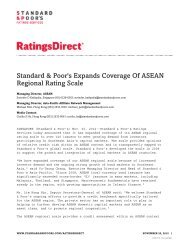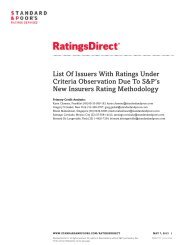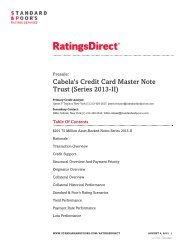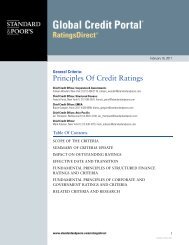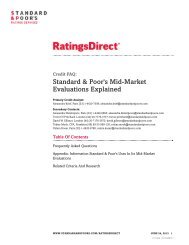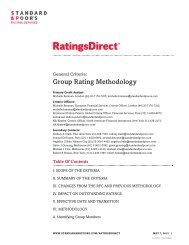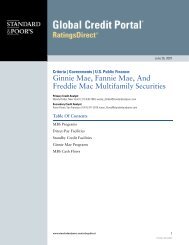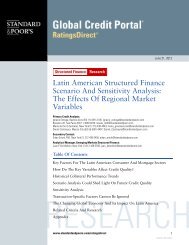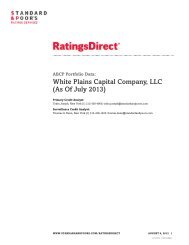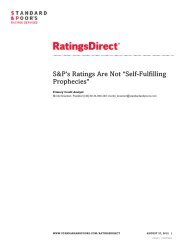What May Cause Insurance Companies To Fail ... - Standard & Poor's
What May Cause Insurance Companies To Fail ... - Standard & Poor's
What May Cause Insurance Companies To Fail ... - Standard & Poor's
You also want an ePaper? Increase the reach of your titles
YUMPU automatically turns print PDFs into web optimized ePapers that Google loves.
<strong>What</strong> <strong>May</strong> <strong>Cause</strong> <strong>Insurance</strong> <strong>Companies</strong> <strong>To</strong> <strong>Fail</strong>--And How This Influences Our CriteriaRatingsDirect). Parts of the new criteria address what we consider as the key causes of insurer distress, and include theexpansion of country and risk analysis in our <strong>Insurance</strong> Industry And Country Risk Assessment (IICRA), an enhancedliquidity analysis, capital metrics that focus more on asset-liability risks, and the larger role for enterprise riskmanagement (ERM) for insurers with complex risks.More idiosyncratic causes of failure, such as specific issues with management and governance, are the focus of ourcriteria for assessing the effectiveness of management and of risk management structures. In compiling our revisedGroup Rating Methodology, we considered cases where subsidiaries collapsed or where, in our opinion, they wouldhave done so in the absence of group support.Past PerformanceSeveral periods of heightened stress spanning the past three decades, which resulted in an increased number ofinsurance company failures, inform our criteria. A number of these stress periods were more industry-specific thanmacroeconomic, although local economic conditions reinforced the Japanese situation outlined below, and sovereigndistress led to the Russian example:• 1984-1989: A number of predominantly casualty insurers in the U.S., including Mission <strong>Insurance</strong> Co. and TransitCasualty <strong>Insurance</strong> Co., became insolvent as loss reserves proved deficient following a period of inadequate pricingindustrywide;• 1992-1994: Several significant U.S. life insurers, including Executive Life <strong>Insurance</strong> Co., Mutual Benefit Life<strong>Insurance</strong> Co., and Confederation Life <strong>Insurance</strong> Co., failed due to a combination of illiquid asset concentrationsand a lack of liquidity to meet maturing liabilities;• 1999: The Russian Federation's selective default on some of its bonds led to severe pressure on the country'sinsurers holding these bonds, amounting to technical insolvency for some smaller insurers.• 2000: Japanese life insurers, including Chiyoda Mutual Life <strong>Insurance</strong> Co., Kyoei Life <strong>Insurance</strong> Co., and <strong>To</strong>hoMutual Life <strong>Insurance</strong> Co., voluntarily entered rehabilitation proceedings or closed their insurance business underregulatory order because guaranteed interest rates on savings products were no longer sustainable given lowinterest rates in Japan; and• 2002-2005: Several international non-life insurers and reinsurers failed, including Mutual Risk Management Ltd.,Trenwick Group Ltd., GLOBALE Rueckversicherungs-AG, and Converium Reinsurance (North America) Inc.,predominantly due to deficient reserves for casualty lines following a period of inadequate pricing industrywide,compounded by weak risk management.Perhaps surprisingly, the global financial crisis that began in 2007 failed to trigger a wave of life and non-life insurerdefaults among rated companies. In fact, not one significant insurer that <strong>Standard</strong> & <strong>Poor's</strong> rated at the time (outside ofthe bond and mortgage insurance sectors) has defaulted due to the financial crisis. Insurers have defaulted or comeunder stress because of problems largely outside of their traditional insurance businesses (such as expansion intofinancial derivatives for American International Group Inc. [AIG]). Certain bond and mortgage insurers have alsodefaulted. However, these two sectors are outside the scope of the new insurance criteria (see "Bond <strong>Insurance</strong> RatingMethodology And Assumptions," Aug. 25, 2011, and "U.S. Mortgage Insurer Sector Outlook Remains Negative--AndThe Clock's Ticking," published on March 1, 2012).WWW.STANDARDANDPOORS.COM/RATINGSDIRECT JUNE 13, 2013 41144346 | 300323561




